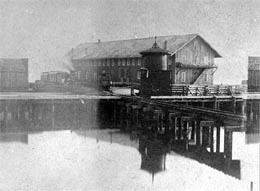On January 5, 1874, scheduled service on the Pacific Division of Northern Pacific Railroad (NP) begins between New Tacoma and Kalama. New Tacoma is located in Pierce County in the southern part of the Puget Sound region and Kalama is located in Cowlitz County on the Columbia River north of Vancouver. The fare is $6 with $1 more for the ferry ride to Portland. The transcontinental railroad still needed 1,500 miles of track between Kalama and Bismarck, Dakota Territory.
The NP picked New Tacoma on Commencement Bay as the western terminus of its transcontinental railroad, but then the Panic of 1873 occurred and contractors stopped all work. Several NP investors, Frederick Billings, Charles Barstow Wright, and George W. Cass, put up $220,000 to complete the line to New Tacoma. The NP got Skookum Smith to take over the job and he got to Lakeview, 10 miles south of New Tacoma on November 1. He decided on a cheaper shortcut into New Tacoma down a steep grade instead of by way of the longer route along Puget Sound. Then Smith ran out of money. The workers petitioned Territorial Governor Elisha Ferry for help and pledged to occupy the right of way until they were paid $73,000 in back wages.
Subcontractor Henry Failing and NP Vice President John C. Ainsworth came up with a combination of cash, promissory notes, and tokens good at the Hanson-Ackerson Mill Company store in New Tacoma to get the men back to work. The 2 percent grade reached New Tacoma and the first train chuffed into town in late November with Mr. and Mrs. William Blackwell and furnishings for the Bay View House. The Pacific Division was officially dedicated on December 16, 1873, amid grandiose speeches and the obligatory final spike.
The Oregonian of Portland wrote that on May 14, 1875, 60 passengers boarded at Kalama, half of whom got off at stations en route to New Tacoma. There were three carloads of merchandise, two of sheep, and three of cattle. Six empty flatcars were destined to transport limestone back to Kalama.

